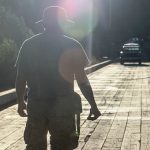When it Comes to Climate Change, the Time is Now
Darkened skies appeared apocalyptic over Prince George, B.C. this summer. Photo by Mary MacDonald
By Nikki Skuce
In August, people in Prince George, B.C. woke up to the sun blotted out from smoke—an eerie night sky at 9 a.m. that could only be described as apocalyptic.
Residents across the northwest had already endured days of closed windows and time indoors, given smoky skies and off-the-charts air quality. It was reported that many suffered feelings of ecological grief.
The last two years in British Columbia have been the worst wildfire seasons on record, burning over 1.2 million hectares. A number of communities were evacuated. Some lost their homes. While it’s been described as “the new normal,” it isn’t. Things are going to get worse before they get better, and they’ll only get better if we actually undergo the socio-economic transformation needed for our collective survival.
Earlier this year, there was tension as snow melted and signs of spring emerged across B.C.’s northwest: how were the salmon going to fair? Predictions were dire, expected to be the lowest on record with fewer than 600,000 returning in the Skeena watershed. By early May, recreational fishing for all salmon—chinook, sockeye, pink, coho—on the Skeena and Nass rivers was closed “until further notice.” Many First Nations decided not to fish sockeye, to conserve now for a more hopeful future.
While wildfires raged and salmon were scarce, people from around the world followed the tragedy of Tahlequah, the southern resident killer whale who grieved by carrying her dead baby for over two weeks. The heart-wrenching story put a spotlight on the diminishing orca population whose primary food source, chinook salmon, is declining all along the west coast. This year’s chinook returns to the Fraser River were dismal and conservationists say not enough is being done to protect the salmon or the orcas.
Despite the “warm blob” in the Pacific, rising river temperatures, lower water levels and hot, dry summers, we seem slow to connect these impacts to climate change. As a writer in the New York Times put it: “The catastrophe is now, even if it’s almost impossible for most of us to see it.”
As a writer in the New York Times put it: “The catastrophe is now, even if it’s almost impossible for most of us to see it.”
When an oil tanker spills, petroleum washes up on shore and oily birds and dead otters capture our attention. We see the devastation and calculate the risks. When science shows the ozone layer depleting and identifies chlorofluorocarbons (CFCs) as catalysts, we act to ban their use. Air freshener versus livable planet.
It’s harder to relate to the alarm bells on climate change when those hotter summer temperatures feel kind of nice; when our baselines shift of what “normal” is; when the solutions are complex.
As time goes by, all those targets we were supposed to achieve with the Kyoto Protocol in the 1990s now need far more drastic measures on far more drastic timelines. A new report out by climate scientists tells us that we are much closer to uncontrollable climate change than previously predicted. Following the report’s release, UN Secretary-General António Guterres told global leaders that, “If we do not change course by 2020, we risk missing the point where we can avoid runaway climate change.”
Even more recently, the Intergovernmental Panel on Climate Change (IPCC) released a report detailing the risks of drought, floods, extreme heat and poverty for hundreds of millions of people if we add another 0.5 degrees to average temperatures. The world’s leading climate scientists are warning we have only a dozen years to keep global warming to a minimum of 1.5 degrees, where our ecosystems remain more or less intact.
We’ve been told for decades that climate change means less predictable weather and more frequent and dramatic weather events. Now it’s a regular occurrence to hear of massive hurricanes, typhoons, tornadoes, tsunamis and earthquakes. Catastrophic floods and droughts can make the news on the same night. The last four years have been the hottest years globally.
While we increasingly face impacts from climate change, carbon-intensive economic interests continue to polarize public opinion and block progressive policies that would cut profits. Some of us live off-grid or are back-to-the-landers, but none of us can fully choose to live in a low-carbon society. As George Monbiot writes in The Guardian, “The problems we face are structural: a political system captured by commercial interests, and an economic system that seeks endless growth. Of course we should try to minimize our own impacts, but we cannot confront these forces merely by ‘taking responsibility’ for what we consume.”
“The problems we face are structural: a political system captured by commercial interests, and an economic system that seeks endless growth. Of course we should try to minimize our own impacts, but we cannot confront these forces merely by ‘taking responsibility’ for what we consume.”
When it comes to climate change, time is not on our side. We need to push for change before it is too late: Vote. Be active citizens. Advocate for change. Support those that do. Stay informed. Share facts and stories. Divest from carbon pollution. Know your neighbours. Build community. Live simply.
The beautiful autumn leaves are falling, the smoke has cleared and the salmon returns were a bit better than expected. Before we get hit with the next storm, we need to join forces to support each other and act just as we did during the wildfires and evacuations.
After all, the time is now.
Nikki Skuce enjoys commuting by bike but has never self-propelled herself across the country, let alone the continent. She is the director of the Northern Confluence Initiative based out of Smithers, B.C.




